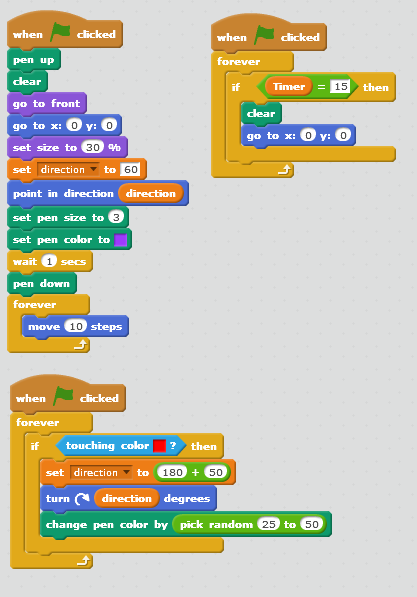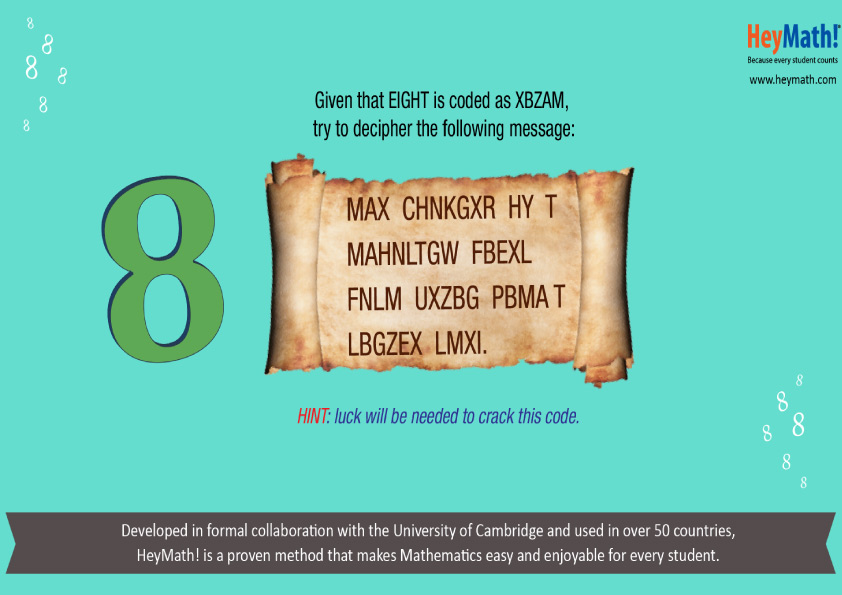If you have sharp eyes, this task is for you! Compare the two pictures below to spot the five differences between them.

Test your eye for detail with this fun spot-the-difference activity! How quickly can you find them all?
If you have sharp eyes, this task is for you! Compare the two pictures below to spot the five differences between them.

Give coding a creative twist and come up with your own colourful Rangoli! Read on to find out more…
In our previous piece, we worked on creating an animated based on the harvest festival of Pongal. Click here to read the article. In this piece, let’s try creating a Rangoli animation using Scratch! (Missed the introduction and wondering what Scratch is? Click here to catch up)
Try using the example program below to create a fun, colourful Rangoli.

Your output will look like this:
What are you waiting for? Get ‘Scratch’ing!
Here are five interesting Mathematical problems for you to solve! Can you crack them on the first try?
Can you solve these Mathematical problems?
We often follow instructions from a recipe for our cooking. Sometimes, the biggest reason for confusion is the unit of measurement. Become familiar with an easy conversion chart…
More often than not, we find ourselves experimenting a little bit in the kitchen. We pick up a recipe book, and try our hand at some cooking. Whether it is experimenting or cooking regularly, one of the most important aspects is to measure the ingredients correctly, so that we add the right portion. Here’s a common visual from the kitchen…
Normally, it is easy to keep track of time, as universally, we follow hours, minutes and seconds. But for other measurements such as grams, ounces, millilitres, degrees centigrade or fahrenheit, we better have a conversion chart until we become familiar with it. Here’s a conversion chart with a rough approximation to the nearest round number.
Hope that sorts out some of the confusion related to measurements. Happy cooking!
The importance of sports and fitness in one’s life is invaluable. Let’s take a look at the ‘Khelo India’ initiative by the Government of India…
A fit and healthy individual leads to an equally healthy society and strong nation. Sports is an extremely important component for the overall development of our nation. It’s time we inspire young talent, give them top-notch infrastructure and training of the highest level. We need to inculcate a strong spirit of participation in sports that enables players to demonstrate their true potential. Only then can India realise its dream of becoming a sports super power.
The Khelo India programme has been introduced to revive the sports culture in India at the grass-root level by building a strong framework for all sports played in our country and establish India as a great sporting nation. To accomplish the above objectives, the Khelo India programme has been divided into 12 verticals, namely:
Khelo India School Games, which are a part of the Khelo India programme, are being held from 31st January to 8th February, 2018 in New Delhi. Under-17 athletes have been invited to participate across 16 disciplines, which are as follows: Archery, Athletics, Badminton, Basketball, Boxing, Football, Gymnastics, Hockey, Judo, Kabaddi, Kho-Kho, Shooting, Swimming, Volleyball, Weightlifting, and Wrestling.
Source : Khelo India | Ministry of Youth Affairs and Sports
In this series, we shall explore some of the historical cities that have been continuously inhabited and have been more than just a blip through civilisation…
Cities have played an important role in the advance of civilisation. Here are some present-day cities from the time period over which they have been continuously inhabited. There is always a dispute on how “old” they are, and the variations on the definition of a “city” as well as “continuously inhabited”, but they’ve always had cultural or religious significance. Let’s take a look…
In this feature of ‘complete the drawing’, let’s see if you can bring some of these characters to life…
Here are three living objects. You need to complete the drawing from the partially drawn figure. You can download and print the exercise sheet. There is always going to be a bit of trial and error. So it’s okay to use an eraser! Move the slider to get a look at the completed image
1. Here’s the sketch of a horse that you need to complete using a pencil. A thin outline should do.
2. Here’s a picture of a girl dreaming. Some of the parts are missing – a bit of free hand drawing should complete it.
3. Here’s a dog peeping in. Complete the drawing using thin lines or strokes..
Here’s something that’s familiar to most of us – parts of a school! Let’s take a look…
A school is an institution designed to provide learning spaces and learning environments for the teaching of students under the direction of teachers. Remember that the focus is on learning environments, supported by essential services. Click on the hotspots to learn more…
Put on your thinking caps, it’s time to crack another code! Can you decipher this secret message?
The number eight is considered to be lucky in China. The Chinese word for eight sounds similar to the word for wealth. Hence many believe this number to be connected with prosperity.
Take a look at the code below and grab a pencil and paper. Can you decipher the code? Once you have cracked the code, fill it in the space below.

January 18 was Winnie-the-Pooh Day! A day to relax, eat honey and play Poohsticks. Read on to find out more about the lovable bear and his friends.
January 18 was Winnie the Pooh Day. It celebrates the world’s most favourite bear. So, why January 18?
Because it is the birth anniversary of A. A. Milne, the creator of this winsome bear. The idea of a lovable bear took shape in Milne’s mind when he saw his son – Christopher’s teddy bear. And of course, Christopher Robin was characterised with his son in mind. Soon, Winnie got himself some friends — Tigger, Piglet, Eeyore, Kanga and Roo – all of whom were part of Christopher’s collection of stuffed toys. Owl and Rabbit were probably the only imaginary additions.

How the name came to be:
The story of how Winnie-the-Pooh got his name is fascinating. Christopher Milne named his stuffed bear after a Canadian black bear he often saw at the London Zoo, and Pooh was a swan he met during a holiday.
Go through the timeline below to learn more about the person who gave us Winnie-the-Pooh and all his friends, A. A. Milne.
Let’s Play Poohsticks!

If you have read Winnie the Pooh stories you will be familiar with the game of Poohsticks. Pooh and his friends love to play this game. Would you like to play the game?
Here’s what you need:
1. Find a friend (the more friends, the more fun)
2. Find a bridge over a stream (to find a bridge you may need a map)
3. Find some sticks (you must do this before you arrive at the bridge)
4. Find a supply of food (ask everyone to bring some along)
Rules:
1. Select a stick; show it to your competitor and make sure you are clear whose stick belongs to whom.
2. Check which way the stream is flowing and face the stream upstream.
3. All competitors stand side by side facing ‘upstream’.
4. Each one holds his/her stick at arm’s length over the stream.
5. The first player calls “Ready-Steady-Go!” and all competitors drop (and not throw) their sticks into the water at the same time.
6. Now, go cross to the other side of the bridge and see whose stick emerges first.
7. May the best stick win!